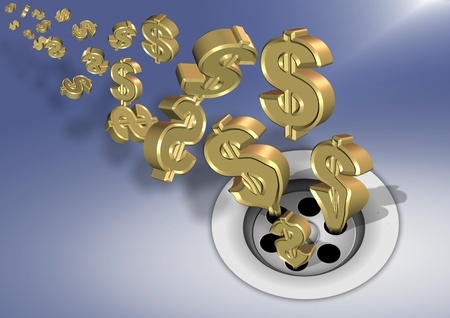One of the most common questions I get as an online business lawyer is how to pay yourself with an LLC. The answer is extremely simple, but it is also extremely complicated at the exact same time. What do I mean? Let's jump into it.
I've been dealing with online businesses for a long time now, and I've also been an entrepreneur and owned my own business for a long time now. So I totally get it when people come to me with this question of how do they pay themselves because back when I was starting out, I remember this was something that I really struggled with as well. It is not intuitively a simple thing to do. We're used to going to work and working for somebody else and getting a paycheck at the end of the month. And at the end of the month, you get that paycheck and it's got federal tax withheld, state tax withheld, FICA, health insurance, all these different things are withheld. And so the thought of owning your own business and then issuing you a paycheck for your own business, I can imagine is extremely daunting.
What I want to do today is talk with you about number one, the easy way, the easy answer to how you need to pay yourself and your business. And then I want to talk to you about some of the more complicated issues that come about when you're talking about how much you're going to pay yourself. And really those questions are number one, how much are you going to pay yourself and how practically speaking are you going to do that? There's a number of different options to use when paying yourself. And so I'm going to go into those a little bit as well.
How do you pay yourself?
So let's start with the basic question. How do you pay yourself? And honest to God, the answer is easier than you would think. I'm going to cover this up to protect the innocent. It's as simple as grabbing one of these out of your drawer, filling it out, writing it out to you, putting the date, writing out the dollar amount that you're going to pay yourself, signing it, and then taking this sucker over to your bank and depositing it. And with today's technology, hopefully you have a bank that will allow you to do mobile deposit because that's the easiest way to do it. So there you have it. That's how you do it. That's how you pay yourself.
But I recognize that for most of you, the question is a little bit more complicated than that. For most of you that's because you want to know, well, what about taxes? How does that work? And what about payroll? Do I need to withhold money? How does all that work? And then finally, the other thing is how much do you pay yourself? How do you know what the right amount is?
Related Resource: Here is the resource we recommend for payroll. (affiliate link)
How much should you pay yourself?
So let's just go over all these one by one. Let's start with, how much should you pay yourself? Now, this is really going to come down to number one, if you have elected to be taxed as just a sole proprietor. So if you have an LLC or a sole proprietorship and you haven't done anything else, and that's all you have them, that is one option. Or if you've elected to be taxed as an S-corporation, that's a different option. We're going to take those one at a time. For people that are just a regular, a sole proprietor, or you have an LLC, you want to know how to pay yourself, basically, you need to look at what the revenue is from your business, how much money you need to keep in your business to pay all your expenses and bills and things that are going to come out. And then you can take out whatever is left as net profit as your salary.
In terms of how much you can pay yourself. The big thing is you need to make sure that you're keeping enough money in the business to pay the bills for the business. And also if you have a really big month, chances are, you don't want to take all that money out and pay yourself that money. You want to make sure you keep money in the business so that you can reinvest into equipment and marketing and perhaps human capital that you might need for your business inventory if you're selling a physical product, different things like that. So you might want to leave money in the business and be very cautious about how much you choose to take out in terms of a salary.
My recommendation would be that once you get the business to where you're comfortable, where you're earning a predictable amount of money each month, this might take three months, it might take a year, it might take five years. I don't know how long it's going to take. Every business is going to be different. But once you get to that point, then what you can do is you can take out a set amount as a salary each month, which is basically what you're going to do what I just showed you with the check. And you're going to write out a check to yourself once a month for however much you're going to take out, $1000, $5000, $10,000. And you're going to write a check to yourself and deposit it in your personal bank account.
What about taxes?
A lot of people are going to say, “Well, Jim, wait a minute. What about taxes? What about all those things?” That will all get sorted out? My recommendation is that you be paying quarterly taxes. So the way I would typically handle this is I follow the profit first system. But basically the idea with this system is that if for every dollar that you receive, you have to put that money to work somehow. So maybe 35 cents is going to go to your salary whatever that might be. 15 cents will go to taxes. Let's say anywhere from two and a half to 5 cents will go to profit. And then the remaining, if my math is correct, 45 cents will go towards expenses for the business.
Now, if you run a business that sells physical products, the number's going to be a little bit different because you're going to take the net numbers after you have paid for all your inventory. And you're going to be looking at the net profit.
Let's assume you're doing consulting. You're doing freelancing. You're doing some sort of design work. Any type of services that you're going to be doing, where every dollar that comes in is theoretically a hundred percent profit because you don't have any inventory to pay, then this is the system that I would be using to calculate how much money you need to keep on hand for all these different expenses and costs of doing business. And then what I recommend is that you transfer the money for taxes let's say, that 15 cents of every dollar that you earn, you're going to transfer into a separate bank account. Then once a quarter, you can pay quarterly estimated taxes to the government. And at the end of the year when you do your taxes, hopefully you have saved up enough that you can pay whatever your tax bill is going to be at the end of the year. You should be good there. And then also you can take some profit distribution at the end of each quarter, based on the amount of money that's in that profit account. That's the way I do it.
Now, the numbers that I use might be a little bit different. I'm just kind of using generic numbers here in terms of the percentages and the breakdown, but that's how you pay yourself. That's how much you pay yourself. And so when you're just getting started and you don't have a lot of revenue coming in, this is a good rule of thumb that you can follow so that you make sure you're taking enough money out of the business to pay yourself an appropriate salary if you want to call it that. You can also call it an owner's draw or salary or distribution, or there's a number of different terms, but they all mean the same thing. How are you going to pay yourself that money out of the business?
So that's if you are an LLC or a sole proprietor. That's how you're going to do it. At the end of the year, you're going to file a schedule C with your tax return. That's going to show the income and expenses from the business and all the net profit, which is income less expenses does not include taxes or your salary because technically what you're taking is a draw each month. All that's going to flow through onto your 1040 on your personal tax return. And that's what you're going to pay taxes on. Got it? You with me so far I hope. Okay.
How do you pay yourself as an S-Corp?
Let's talk about the second option, which is filing an S election. Now I typically tell people to wait until you're earning between $25,000 and $50,000 per year to file an S election. And the reason for that is because there's costs associated with filing an S election. You have to pay for a payroll provider. You have to do a separate tax return. At the end of the year. You may have to hire an accountant to help you make sure everything is done properly. And all that adds up to expenses that basically do not make sense if you're not making at least $25,000 to $50,000 per year because there's not enough in tax savings to help you if you're not making that much. This will kind of make more sense as you get into it.
But basically the requirement if you are an S corporation is that you have to pay yourself a reasonable salary. What is reasonable is going to depend on. The amount that you pay yourself as a reasonable salary is going to vary depending on the business you're in and the type of work you're doing. And basically the rule of thumb here is that if you were to hire yourself to do the work that you're going to be doing in the business, if you were the owner and you're going to hire somebody else to do the work that you're doing, how much would you pay them? That's the amount that you should be paying as a reasonable salary.
For instance, if you were to hire an admin person and a reasonable salary to have an admin person come into your business is $30,000 or $40,000, and you're doing admin work, then you should be paying yourself a reasonable salary of $30,000 to $40,000 if that's the amount of time, or if that's an appropriate salary for what you're doing. If you're the owner of a law firm, for example, and a lawyer, you were going to hire a lawyer to do the work, but you're the lawyer doing all the work, then how much would you pay an associate? Would that be $60,000, $80,000, $100,000? Whatever that might be, that's how much you should be paying yourself as a reasonable salary.
Now, again, you have to go off those numbers I talked about before with profit first to kind of figure out what those numbers should be for your business. And typically again, I recommend that you take between 30% to 40%, 35% is a good number for startups in terms of owner's distribution. And then take an additional 5% to 10% off the top for profit. Now, when you're just getting started again, that number is probably going to be closer to five or two and a half percent because it's going to be a little bit lower because you're going to need more money for operating expenses. But as your business continues to grow, what's going to happen is as you earn more money, more money is going to be allocated towards human capital, which means your operating expenses are going to go up. Your salary is going to go down and your profit distribution is going to go up.
I know that doesn't make a whole lot of sense right now, but conceptually, if you think about it, basically the idea here is that as you grow and your revenue goes up that as the owner of the business, you're going to be paid basically the profit from the business. And you're going to be doing less and less work in the business as you hire more and more people to do the work for you. That's how you scale your business. And this is especially true for an online business although the model might be a little bit different with an online business, because a lot of online businesses can be solo-preneurs and can scale their business quite a bit. But as you start to scale, you can only scale so much before you really need to start bringing on a team to help you with your business.
But ideally as the owner of your business, you should be taking two paychecks. One is going to be your salary. And the other one is going to be a profit check that you earn, regardless of whether or not you're working in the business. Hopefully that makes sense. I know this is really complicated stuff, and this is why I say this is one of those questions that people ask me where the answer is intuitively very simple, but it's also really complicated as well.



